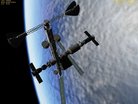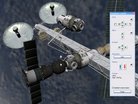|
Mir-2 (project 1993)
Space Station
Description: The station would consist of the DOS-8 core module and a cross beam called
the NEP (Science Power Platform). This was equipped with MSB retractable solar
panels, remote controlled
thruster packages and small scientific packages. Four 3 to 4 tonnes mission modules were planned. The project final
configuration has following modules: ·
Core Module (x1) – DOS-8 , known as
“Zvezda”. Includes primary living quarters including eating,
sleeping and sanitary facilities. This module was build and used in ISS. ·
Service Module (x1) – There is no other
information, except this should be smaller analogue of the
“Kvant-2” module. ·
Docking
Module (x2) –
SO-1 “Pirs” module
with the APDS universal androgynous docking system, and a side hatch for
space walks. ·
Universal Docking Module (x2) – Codename “USM”. Equipped
with gyrodynes for orienting the station and a passive docking port for docking
of Soyuz or Progress ferry spacecraft. Should have 6 docking points and 2 NEP attachment points. ·
Technology
Module (x1) –
Codename “TM”. Materials
experiments equipment. Based
on modified Progress-M2 vehicle. · Biotechnology Module (x1) – Codename “BTM”. Based on modified Progress-M2 vehicle. ·
Earth Surveillance Module (x1) – Codename
“MDZZ”. Based on modified Progress-M2 vehicle. · NEP – Science Power Platform. Mount for 2 solar panels, 2 Solar Gas Turbine Units, Station heat radiator, 4 remote controlled thruster pods and additional science equipment. Inner parts of the NEP should contain gyrodynes and additional energy storage battery arrays. Technical specifications: Designation: DOS
17KS-12801 Project
status: Released, development
continues. ·
Semi-full Version 1.1.0.0 released. ·
Modular Version 1.0.6.0 released. ·
Building scenarios in development. ·
Launch Scenarios in development. ·
Project
Description: ·
Version 1.1.0.0 ð Added core
of the station (includes “Zvezda” and USM modules and whole truss
with solar arrays and VDU’s) as single vessel. ð Core
station vessel have solar arrays which can rotate automatically toward the sun
and radiator, which automatically evades the sun. ð Core
station vessel have real-time automated thrust correction system, which can
compensate asymmetric module docking. ð Added
“manipulator” vessel, which have a working manipulator, and can
move by rails alongside the truss. ð New
building scenario pack, modified to include manipulator and core vessel. ð Modified
scenario pack, representing station building stages, which include core vessel. ð Includes
modified “Progress” ferry vessel for delivering VDU pods. ·
Version 1.0.6.0 ð Includes
all station modules as single vessels. ð Modules
“Zvezda” and NEP-R3
have solar arrays which can rotate automatically toward the sun. ð NEP-L3
truss module joint also can automatically follow the sun, so if solar gas
turbine or solar arrays will be docked to the joint, they will be always in
proper orientation toward the sun. ð NEP-R1
module automatically rotates to evade the sun lightening. ð All solar
arrays, radiators, solar gas turbines and antennas can be stowed. ð Scenario
pack representing station building
stages. Release date: Package
1.1.0.0 – 10 December 2007 Credits: ·
3D modeling – Nikolay (NickD) Dimitrov ·
Programming – Yuri (Kulch) Kulchitski Links: Link
concerning Mir-2 in Orbiter Forum Link
concerning development of Mir-2 in
Orbiter Forum
|





















